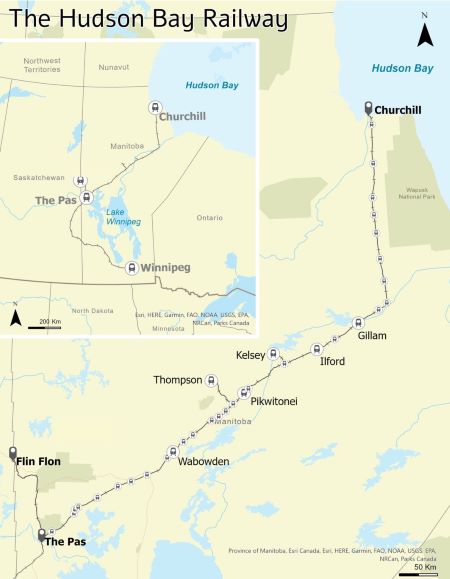Port of Churchill is attracting more investment as an option to diversify trade routes amid U.S. tariffs
 The Port of Churchill (photo at right) in Manitoba is attracting more research and investment as a way to expand Canada’s port options and diversify trade routes and export markets amid the Trump tariff war.
The Port of Churchill (photo at right) in Manitoba is attracting more research and investment as a way to expand Canada’s port options and diversify trade routes and export markets amid the Trump tariff war.
 “Certainly with the U.S. trade wars today, when everyone’s looking for infrastructure to access other markets, Churchill provides that,” said Chris Avery (photo at left), CEO of the Arctic Gateway Group at the Port of Churchill on the Hudson Bay.
“Certainly with the U.S. trade wars today, when everyone’s looking for infrastructure to access other markets, Churchill provides that,” said Chris Avery (photo at left), CEO of the Arctic Gateway Group at the Port of Churchill on the Hudson Bay.
“For a country the size of Canada to have a Northern seaport option to me just makes sense,” he said during a podcast by the ARC Energy Research Institute.
The Arctic Gateway Group owns and operates the Port of Churchill, the only deepwater Arctic seaport in North America, and the Hudson Bay Railway that connects Churchill to southern Canada.
The group is owned by the OneNorth consortium of 41 First Nations in northern Manitoba and the Kivalliq region of Nunavut, and the communities around Hudson Bay and along the railway line and trade corridor.
“Way before Trump was elected president, we were about building trade-enabled infrastructure that would allow the vast resources in western Canada access to global markets through the Port of Churchill,” Avery said.
 The Hudson Bay Railway runs north from The Pas, Manitoba to Churchill, and connects south from The Pas to CN’s Class 1 railway network. (Map of route at right).
The Hudson Bay Railway runs north from The Pas, Manitoba to Churchill, and connects south from The Pas to CN’s Class 1 railway network. (Map of route at right).
The Hudson Bay Railway carries both freight and passengers and is a critical piece of transportation infrastructure for nearly 30,000 people from First Nations, other communities along the line, and the Kivalliq region of Nunavut.
The Port of Churchill and the Hudson Bay Railway have been operating for almost 100 years. For much of the railway’s history it was owned by CN.
Jean Chretien’s Liberal government sold the railway and port to Denver-based private firm OmniTRAX Inc. in 1997. OmniTRAX owned the railway in 2017 when the northern part of the rail line washed out due to abnormal spring weather and flooding.
Avery said when the line washed out, it cut off a vital transportation link for the 900 people who live in Churchill, which is inaccessible by road, plus all the communities in northern Manitoba along the rail line. Also cut off was any trade that went through the Port of Churchill and some of the supply routes to central Nunavut.
“It was largely because the infrastructure was neglected for decades, by American interests,” he said.
OmniTRAX declared a “force majeure” and wouldn’t repair the rail line. “It was sort of a stalemate for 18 months where the American company held Canada hostage somewhat, refusing to repair the railway,” Avery said.
Then in 2018 a deal was reached and the newly created Arctic Gateway Group, in partnership with the federal government, took over the Port of Churchill and the Hudson Bay Railway.
“We’ve invested significant capital into the railway,” Avery noted. “The railway is in better condition than it’s ever been.”
Arctic Gateway Group has installed about 350,000 railway ties and a half-million tonnes of ballast rock foundation that lets water flow through rather than flooding the track, he said.
 “We have a great foundation for the railway, and then on top of that we have great technology to help us monitor the railway and see what’s happening to the railway before it actually happens,” Avery said.
“We have a great foundation for the railway, and then on top of that we have great technology to help us monitor the railway and see what’s happening to the railway before it actually happens,” Avery said.
Ground-penetrating radar mounted on the railway’s locomotives constantly monitors the condition of the track’s foundation. Drones flying overhead measure the levelness of the track and the state of the land around the track.
“We have things like computing power and AI to help us analyze what’s happening,” Avery said.
AI helps identify potential issues and predict where the issues will occur, and satellite-based GPS is used to pinpoint exactly where problems are occurring, he said.
Railway is transporting critical minerals
The Hudson Bay Railway runs along permafrost. So the Arctic Gateway Group is working with researchers, including at the University of Calgary, the Royal Military College and in industry on solutions to address the problem of permafrost melting and heaving.
Technologies used for permafrost range from sophisticated thermosyphon technology that helps keep the ground cold, to simpler solutions like culverts to allow water to flow through, to allowing the permafrost to melt and then installing solid foundations.
“We have great technology in this country that helps us manage permafrost that we maybe didn’t have 30 years ago and maybe didn’t have five years ago,” Avery said.
 Last summer, the Hudson Bay Railway transported 10,000 tonnes of zinc concentrate mined by Hudbay Minerals Inc. in northern Manitoba to the Port of Churchill where it was exported to Europe.
Last summer, the Hudson Bay Railway transported 10,000 tonnes of zinc concentrate mined by Hudbay Minerals Inc. in northern Manitoba to the Port of Churchill where it was exported to Europe.
The railway and port will double the amount of critical minerals exported this year and are tripling capacity to handle critical minerals, Avery said.
“We expect to have grain and agricultural products going through the port this coming season,” he added. “We’re diversifying into different types of agricultural products.”
In March, the Arctic Gateway Group (AGG) and Genesis Fertilizers Limited agreed to establish a framework for cooperation to enhance business opportunities, including new import and export shipments in 2025 and beyond.
AGG and Genesis Fertilizers will cooperate to source and import phosphate and ammonium sulphate supply from international vendors as feedstock for the products, to be produced at Genesis Fertilizers’ planned $2.3-billion fertilizer plant at Belle Plaine near Regina, Saskatchewan.
The parties will distribute the supply domestically through facilities at the Port of Churchill and the planned SuperCenter distribution network of Genesis Fertilizers. Currently, this feedstock is brought into Canada from the U.S. by other importers.
“The Hudson Bay Railway and the Port of Churchill is an idea routing for [companies] to potentially export fertilizer to European markets,” Avery noted.
Another potential opportunity is phosphates (used in fertilizer), which traditionally are imported from the southeastern U.S. But Northern Africa and the Middle East are other sources of phosphates, which can be exported to the Port of Churchill and transported on the Hudson Bay Railway to farmers in western Canada.
Avery said the Arctic Gateway Group is currently focused on repairing and modernizing the port itself, including wharf repairs and freight warehouse upgrades.
The Port of Churchill has accommodated a Panamax-size vessel (capable of carrying 120,000 deadweight tonnes (DWT) in the past, although the more common size of ships is the smaller Handymax type which typically carries 40,000 to 50,000 DWT.
Last year, the group did drilling in the harbour to better understand the current conditions of the ground at the bottom of the harbour. “We can then understand how much dredging we can do and how much depth we can create for vessels,” Avery said.
In February, the Manitoba and federal governments announced a joint $80-million investment to upgrade infrastructure at the Port of Churchill and to support operations and maintenance of the Hudson Bay Railway, with the aim of expanding international trade.
The investment will support the Arctic Gateway Group’s port and rail development vision and plan to expand traffic diversification and growth opportunities and attract private investment partners from the agriculture, mining, fertilizer and resupply sectors.
“Developing the Port of Churchill will advance northern Manitoba’s economy, support trade expansion with Europe and strengthen our Arctic sovereignty as we position Manitoba as a gateway to the Arctic and to the world,” said Lisa Naylor, the Manitoba government’s minister of transportation and infrastructure.
Winter ice limits the port’s sea shipping season
The biggest challenge for the Port of Churchill is that thick winter ice currently limits the port’s sea shipping season to four months of the year, from July to October.
However, Avery said the Arctic Gateway Group has partnered with researcher Feiyue Wang at the University of Manitoba and the Churchill Marine Observatory (which opened last year) on research to get a better idea of how long the sea lanes could be ice free, given the warming Artic due to climate change.
Wang’s research indicates that the sea route actually could be open for six months of the year, Avery said. “But what’s stopping that right now is really the insurance industry.”
Insurance rates for vessels skyrocket after October, based on decades-old data about sea ice conditions that insurance companies are using, he explained.
The Arctic Gateway Group plans to complete the research with Wang by the end of this year and provide the insurance companies with updated data.
“Once they have this data, from an objective point of view, then we can potentially open up the sea lanes to up to six months a year, without any icebreaking,” he said.
Longer term, the University of Manitoba’s data shows that if current climate change conditions continue, the sea lanes could be open 365 days a year within 40 to 60 years.
“When the sea lanes are open, we feel we’re very competitive price-wise [to other Canadian ports] because of the shortened length of transport and lower cost structure,” Avery said.
 Podcast co-host Peter Tertzakian (photo at right), founder of the ARC Energy Research Institute, pointed out that shipping from the Port of Churchill to northern Europe is along a polar route that’s much shorter than shipping from Eastern Canada.
Podcast co-host Peter Tertzakian (photo at right), founder of the ARC Energy Research Institute, pointed out that shipping from the Port of Churchill to northern Europe is along a polar route that’s much shorter than shipping from Eastern Canada.
Avery said the polar route shortens the transport by about three shipping days, which reduces shipping costs.
Russia, in establishing its Northern Shipping Route, has invested in ice-breaking transport ships and is building the Yamal LNG project at the Russian Port of Sabetta, located on the Yamal Peninsula in Siberia – farther north than the Port of Churchill.
Novatek, a state-owned Russian gas company and the Russian government ae involved in the LNG facility’s development.
Tertzakian said if Russia is capable of such development in the Arctic, “why is it that Canada with equal resources and ingenuity arguably can’t do it?”
Churchill’s northern latitude and cold weather make for more efficient natural gas liquefaction compared with hot climates in competitor regions such as the U.S. Gulf Coast and the Middle East, Tertzakian said.
Avery also pointed out that Manitoba has abundant clean energy from hydroelectricity that could supply an LNG terminal in Churchill.
The airport at Churchill also can accommodate the largest transport and passenger aircraft in the world, and the town’s infrastructure is built to handle 5,000 people.
“It’s a great set-up infrastructure to help us assert our sovereignty in the North,” Avery said.
Multi-use corridor from Alberta to Churchill proposed
Calgary-based Western Energy Corridor Inc., a group of six energy and pipeline executives, has proposed a multi-use corridor from central Alberta to Churchill, including an LNG plant and export terminal at Churchill.
But the company’s request that the federal government undertake a detailed environmental review and Indigenous consultation of its proposed corridor has been denied twice by Ottawa, in 2021 and 2022.
Last month, Western Energy Corridor wrote to Liberal leader Mark Carney saying the company was ready, if there’s clear federal and provincial support, to submit a third request to the federal Impact Assessment Agency of Canada to initiate a detailed review.
Alberta Premier Danielle Smith, who was copied on the letter, responded to say her government supports the creation or expansion of economic corridors, and “recognizes the potential of the Port of Churchill to serve as a gateway for exporting Alberta’s goods and resources to other parts of the country and to international markets.”
Establishing a utility corridor between Alberta and the Port of Churchill would be a complicated undertaking, requiring significant investment in both the utility corridor and infrastructure improvements at the seaport, she said.
“Achieving this will require participation from all levels of government, including the federal government and the three prairie provinces, as well as Indigenous groups, impacted communities, industry and other stakeholders,” Smith said.
The Liberals’ platform document, which Carney released on April 19, commits to “build the Arctic economy with more ports, highways, railways, and energy infrastructure, with a focus on dual-use infrastructure that grows our economy, reinforces our partnership with Indigenous communities, and secures our sovereignty.”
 The U.S. and Russia are now discussing Arctic cooperation around natural exploration and trade routes in the Arctic, said Jessica Shadian (photo at right), president and CEO of the Arctic360 think tank.
The U.S. and Russia are now discussing Arctic cooperation around natural exploration and trade routes in the Arctic, said Jessica Shadian (photo at right), president and CEO of the Arctic360 think tank.
Canada’s North has critical minerals and the U.S. has never agreed that the Northwest Passage is in internal Canadian waters, she noted during a panel session on “Navigating Canadian Arctic Sovereignty,” at the recent Thin Ice event hosted by the Canada West Foundation.
When Russia built its Northern Sea Route, it carried out extensive feasibility studies including on economic feasibility, Shadian said, adding that Canada needs to do the same.
“We need to first figure out what we have, what we need, how much it’s going to cost and how we’re going to finance that,” she said. “We have to build out a strategy for what we need.”
Avery said the Port of Churchill will never replace ports in Vancouver or Montreal. However, it can be a viable option when other ports are impacted by severe weather events, wildfires and labour disputes, he said.
“I think there’s a huge demand and a huge need for good jobs and good opportunities in the North,” he said. “I think we’re ready for that. It’s just a matter of providing the opportunities.”
R$
Events For Leaders in
Science, Tech, Innovation, and Policy
Discuss and learn from those in the know at our virtual and in-person events.
See Upcoming Events
You have 1 free article remaining.
Don't miss out - start your free trial today.
Start your FREE trial Already a member? Log in
By using this website, you agree to our use of cookies. We use cookies to provide you with a great experience and to help our website run effectively in accordance with our Privacy Policy and Terms of Service.




